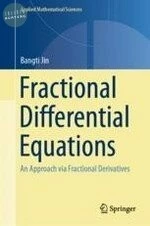
QUANTUM PHYSICS (2版)
相關熱銷的書籍推薦給您
書名:Quantum Physics of Atoms, Molecules, Solids, Nuclei, and Particles 2/E
作者:EISBERG
出版社:WILEY
出版日期:1985/02/14
ISBN:9780471873730
原價:
2300
售價:
2254
現省:
46元
立即查看

Fractional Partial Differential Equations
類似書籍推薦給您
【簡介】
This monograph offers a comprehensive exposition of the theory surrounding time-fractional partial differential equations, featuring recent advancements in fundamental techniques and results. The topics covered encompass crucial aspects of the theory, such as well-posedness, regularity, approximation, and optimal control. The book delves into the intricacies of fractional Navier–Stokes equations, fractional Rayleigh–Stokes equations, fractional Fokker–Planck equations, and fractional Schrödinger equations, providing a thorough exploration of these subjects. Numerous real-world applications associated with these equations are meticulously examined, enhancing the practical relevance of the presented concepts.
The content in this monograph is based on the research works carried out by the author and other excellent experts during the past five years. Rooted in the latest advancements, it not only serves as a valuable resource for understanding the theoretical foundations but also lays the groundwork for delving deeper into the subject and navigating the extensive research landscape. Geared towards researchers, graduate students, and PhD scholars specializing in differential equations, applied analysis, and related research domains, this monograph facilitates a nuanced understanding of time-fractional partial differential equations and their broader implications.
【目錄】
立即查看

FRACTIONAL DISCRETE CHAOS
類似書籍推薦給您
In the nineteenth-century, fractional calculus had its origin in extending differentiation and integration operators from the integer-order case to the fractional-order case. Discrete fractional calculus has recently become an important research topic, useful in various science and engineering applications. The first definition of the fractional-order discrete-time/difference operator was introduced in 1974 by Diaz and Osler, where such operator was derived by discretizing the fractional-order continuous-time operator. Successfully, several types of fractional-order difference operators have then been proposed and introduced through further generalizing numerous classical operators, motivating several researchers to publish extensively on a new class of systems, viz the nonlinear fractional-order discrete-time systems (or simply, the fractional-order maps), and their chaotic behaviors. This discovery of chaos in such maps, has led to novel control methods for effectively stabilizing their chaotic dynamics.
The aims of this book are as follows:
Presenting the recent developments, trends, research solutions, applications and open problems related to fractional-order chaotic maps;
Illustrating many interdisciplinary applications, like modulization, control, circuits, security and encryption;
Including all theories associated with chaos, control and synchronization of discrete-time systems;
Providing a useful reference on the topic of fractional-order chaotic maps and their applications.
Sample Chapter(s)
Preface
Chapter 1: Discrete Fractional Calculus
Contents:
Discrete Fractional Calculus
Chaotic Methods and Tests
Chaos in 2D Discrete Fractional Systems
Chaos in 3D Discrete Fractional Systems
Applications of Fractional Chaotic Maps
Readership: Graduate students and researchers in chaos, applied mathematics, computer science and engineering.
原價:
2411
售價:
2290
現省:
121元
立即查看

Numerical Treatment and Analysis of Time-Fractional Evolution Equations
類似書籍推薦給您
立即查看

SPECIAL FUNCTIONS OF FRACTIONAL CALCULUS
類似書籍推薦給您
This book aims to provide an overview of the special functions of fractional calculus and their applications in diffusion and random search processes. The book contains detailed calculations for various examples of anomalous diffusion, random search and stochastic resetting processes, which can be easily followed by the reader, who will be able to reproduce the obtained results. The book will be intended for advanced undergraduate and graduate students and researchers in physics, mathematics and other natural sciences due to the various examples which will be provided in the book.
Sample Chapter(s)
Preface
Chapter 1: Mathematical background
Contents:
Mathematical Background
Fox H-Function and Related Functions
Elements of Random Walk Theory
CTRW on Combs
Heterogeneous Diffusion Processes
Diffusion Processes with Stochastic Resetting
Random Search
Diffusion on Fractal Tartan
Finite-Velocity Diffusion
Appendices:
Functional Calculus Stochastic Differential Equations Large Deviation Principle Fractals and Fractal Dimension Implementation of Wolfram Mathematica
Readership: Advanced undergraduate and graduate students, researchers in the fields of stochastic processes, fractional calculus, anomalous diffusion, random search, stochastic resetting, econophysics.
原價:
3185
售價:
3026
現省:
159元
立即查看

Fractional Differential Equations 2021 <SV>
類似書籍推薦給您
立即查看

 華通書坊
華通書坊














